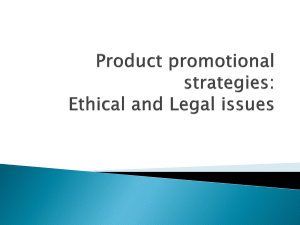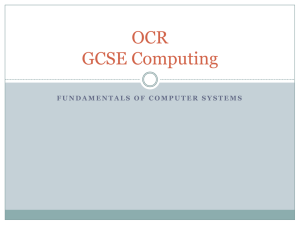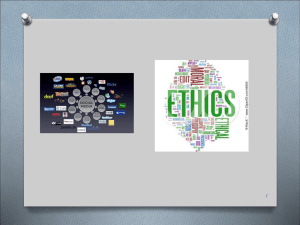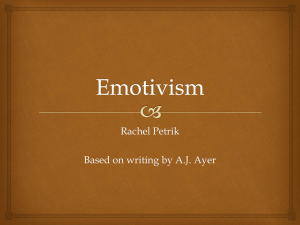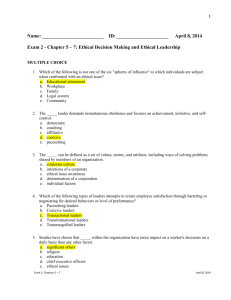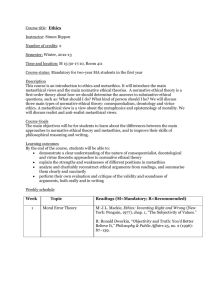Power, Ethics, and Leadership
advertisement
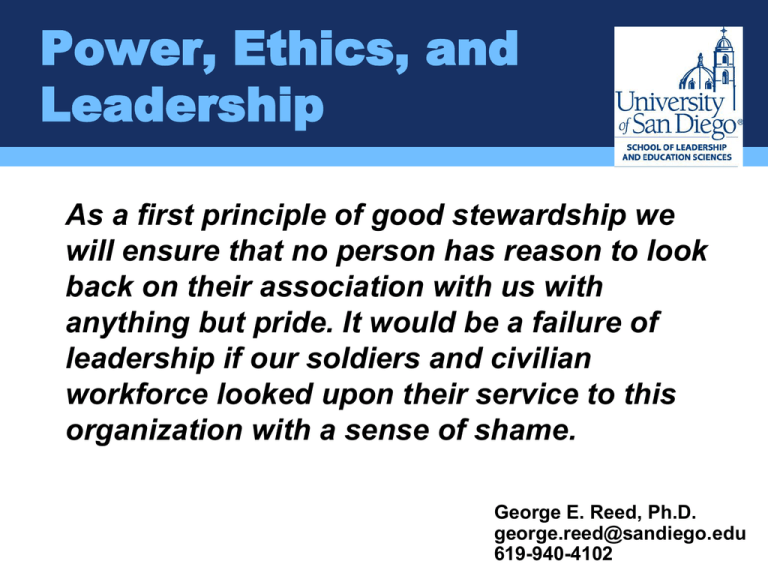
Power, Ethics, and Leadership As a first principle of good stewardship we will ensure that no person has reason to look back on their association with us with anything but pride. It would be a failure of leadership if our soldiers and civilian workforce looked upon their service to this organization with a sense of shame. George E. Reed, Ph.D. george.reed@sandiego.edu 619-940-4102 Agenda Thoughts on Leadership Fostering an ethical climate Character or situation as drivers of individual behavior? Bathsheba Syndrome- “Screwing Up Big Time” Americans hold the military in a position of extraordinary trust and confidence Rosenthal, S. A. (2011). National Leadership Index 2011: A National Study of Confidence in Leadership. Center for Public Leadership, Harvard Kennedy School, Harvard University, Cambridge, Massachusetts. Leadership Style The pattern of leadership behavior as perceived by others. Style always matters. Video trumps audio. Leaders should do more listening than telling, more understanding than directing. Speaking up and listening down People desperately want to please you. Every action has a reaction. It is lonely at the top. There is no such thing as a casual conversation. The boss can never have a bad day. Discussion: What can you do you? What specific actions can you take to foster an ethical climate; where straight-talk flows up and down the organizational structure? Fostering an Ethical Climate Reward and develop the straight-talkers; protect the mustangs. Celebrate those who take principled positions. Receive bad news well; never shoot the messenger. Be a role model for speaking truth to power. Two ears, two eyes, and one mouth- use them in those proportions. Watch for “weak signals.” “We don’t do that here” equals success. Fostering an Ethical Climate Tolerate some level of failure for the sake of learning and experimentation. Conduct after-action reviews, not post-mortems. You don’t have to pretend to be the smartest person in the room. Avoid giving the answer before you ask the question. Praise in public, criticize in private. Don’t be a toxic leader. Charting the ethical slideRed Flags • Failure to note the situational imperative (systems and pressures). Ethical breaches are chalked up to individual character flaws. • Rules and guidelines become a “game” to be won or lost. • This is a new environment that calls for new rules– the old rules no longer apply. • Ethics becomes the purview of the lawyers instead of the leaders. • Mission/resource mismatch. • It’s all about the rules (minimalist approach) and not about the values (inspirational approach). Charting the ethical slideRed Flags • Principled positions are not celebrated. • There is no one who will listen when an ethical dilemma or transgression is pointed out; whistleblowers are destroyed. • Values are simply posters and bumper stickers– “Do the right thing.” • The results are all that is important and there is no discussion about how the results are achieved– “Just get it done.” • There are conflicts between espoused values and enacted values. Ripped from the Headlines The Bathsheba Syndrome • Ethical violations are the by-product of success. • Successful people become complacent and lose focus. • They have privileged access to information, people or resources. • They have an inflated belief in their personal ability to manipulate outcomes. • Temptation comes with success and privilege. The Character Project • Calls for self-mastery and habituation to the higher good. Traits and virtues. (Aristotle). • Unethical behavior is the result of weakness, pathology, undeveloped character, or lack of moral fiber. • We see this in character development programs (indoctrination, exhortation, values). • Prominent in leader development and legalistic approaches. • Locus of control sits with the individual moral agent. • A world of good apples and bad apples. Issues • We just aren’t very good at influencing character. • Mostly based on armchair theorizing. • People are remarkably inconsistent in their character and personality traits– good today, bad tomorrow, or good in one context and bad in another. • Situation and context influence human behavior much more than we think. It’s Not About Character all Stanford Prison Experiment Obedience to Authority Experiments The Helium Stick Eyes on the cup experiment Dan Ariely- Just How Moral Are We? Start at 4:18 Stop at 13:10 Golden Nuggets • The profession of arms is one of significant moral hazard. • Leadership is a key variable in promoting unit climate. • Bad stuff happens. The question is, just how fast will you hear about it and have an opportunity to intervene. • Peer behavior has a powerful influence on ethical behavior. • Our conduct is influenced by subtle psychological and social cues. • We cannot rely on “character.” • We can and should prepare leaders for temptations inherent with power and authority. Keep in touch George E. Reed, Ph.D. 619-940-4102 george.reed@sandiego.edu george.reed@us.army.mil Discussion Questions What can we do to ensure that we will hear from those who have moral misgivings about what’s going on in their unit? What can we do to encourage the expression of alternative views, doubts, and loyal dissent? What techniques and tips can you recommend to ensure that your colleagues are working in a manner consistent with Army values. What can we do to encourage collaboration and flow of information across organizational boundaries?






